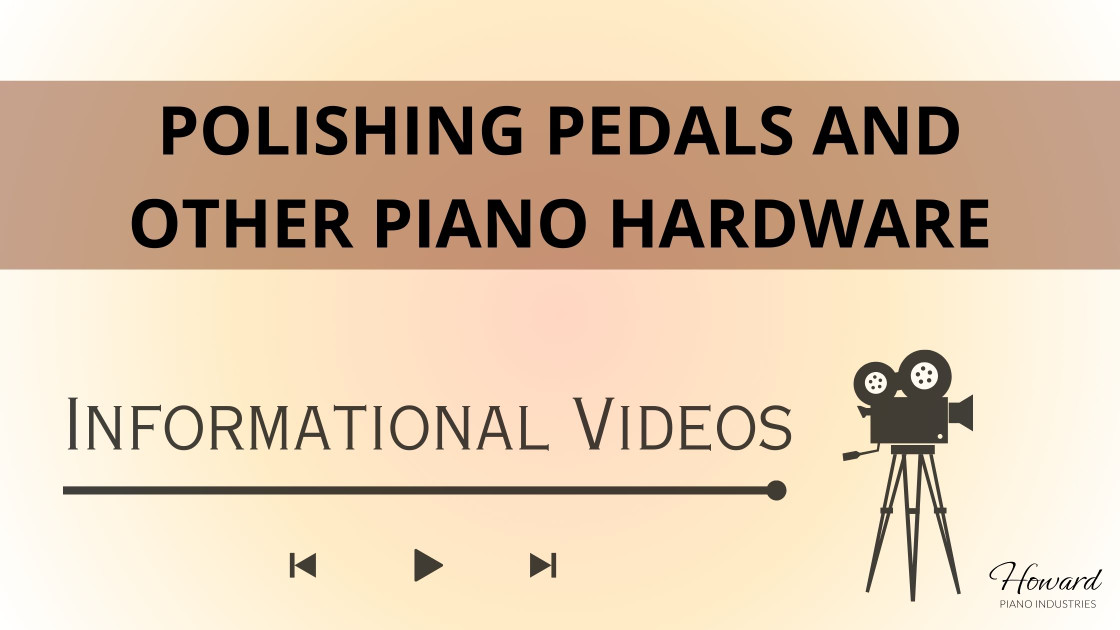Polishing Pedals and Other Piano Hardware
Sep 21, 2023
Polishing Pedals and Other Piano Hardware (Piano Tuning and Repair)
Welcome to our Series on Piano Tuning and Repair.
Brass or Nickel parts on the case of a piano such as the pedals can become dingy looking over the years. Polishing them up is a fairly easy task which can be done with some standard metal polish and a rag. This video shows the process of brightening up the pedals on your piano.
If you want to see more of our Piano Tuning and Repair Series, click here to access the entire playlist.
Video Transcript:
Introduction
Hi there, welcome to another video here from Howard Piano Industries. We're gonna be showing you today, just a basic method of polishing up pedals or other type of hardware. Often times, they'll get corrosion on them, or they'll get dirty or dingy looking, especially the pedals and other brass or nickel plated nickel hardware.
So there's a couple different things you can do to polish up the brass pieces. We're just going to show you a simple way today. What I do is a product called, Noxon 7, there are other metal polishes as well but this is the one I've always used. Flitz is another one that we used like on the Agraffes, and balance rail and front rail pins and so forth. But like for the brass pieces I tend to like to use Noxon 7.
As you can see, these are brass pedals and I've done the one on the left already. There's a big difference in appearance from the left pedal to the middle pedal. The right pedal now as you can see, this is kind of ugly looking as well, but the right pedal, you might notice where you put your foot, because it's used all the time. It might actually be a little bit shinier than the other two pedals because it gets used so much. That gets kind of somewhat polished by your foot when you're playing that pedal.
So you can see that the front of this looks come somewhat polished even though up here is kind of dingy looking compared to that one. But you can see that's because it gets pushed down by the foot and they kind of rub some of the dirt off or corrosion offers so forth.
Polishing Process
So I'm gonna show you how easy this is, I just take a regular paper towel, I mean you can use a microfiber cloth or something like that but, because I usually like to just throw them away, l just tend to use a paper towel. Noxon 7, you'd have to shake it up before you use just because it does settle after it's been sitting for awhile.
I'll just put some on my cloth here or my paper towel, and then I'll just rub a little bit on the surface of the pedal and then, just continue rubbing it. You can let it sit a little while so, that it kind of works its way into the corroded stuff as it sits longer. As you can see it's starting to shine up fairly quickly and just keep rubbing, and at some point you want to add probably a little more of the polish or cleaner this is actually a cleaner and polish all-in-one.
So put on a little bit more. Now when you do the pedals, you can do it this way if you're not in the process of taking everything apart but, it actually is easier to do the polishing of the pedals you know if you've got them taken out you know like if you've got an upright piano sometimes they're a little bit difficult to get off. But if you're replacing all the felts and so forth on a grand piano, pedal lyre it's much easier to do the polishing of these pedals with the pedals out of the lyres. So you know you can do it that way.
I'm showing you this way, to demonstrate that it can be done without having to disassemble the whole piano. Now once you've got it kind of mostly polished, you can take the clean part of the rag or paper towel or whatever it is you're using. You want to kind of buff that up a little bit, and that's what kind of brings it to the really good shine. I could probably could have gone a little bit further with this one, and actually once the Flitz, which is another product that I mentioned, it does work really good, and if I were to use that on this it would shine it up even more. The Flitz goes one step further, it doesn't clean the majority of the stuff off as well as the Noxon 7, you know so typically that's why I just try to use Noxon 7 first. If I were to go back over this with the Flitz you know it looks pretty good now, but you'd notice a big difference in kind of that extra step to make it even much shinier if you were to use the Flitz, after you use the Noxon 7. So if you're polishing things such as like for example, Agraffes, you know what I'll usually do is because those are usually pretty grungy looking over the years.
What I'll do is I'll use the Noxon 7 first and then I will go ahead and finish him off with the Flitz. That's kind of a good way to do it but now we'll go to the right pedal here. And so you can see that polished up pretty quickly. And so this one will continue, but we'll leave it there for now. Anyways, but you can see that it's fairly simple process to polish those up. Only takes a few minutes and makes a big difference in the appearance of your brass parts.

